Learn how to make Whole Wheat Sourdough Bread with my favorite recipe. Sourdough starter, sea salt, water, and freshly ground wheat make up this simple and wholesome loaf.
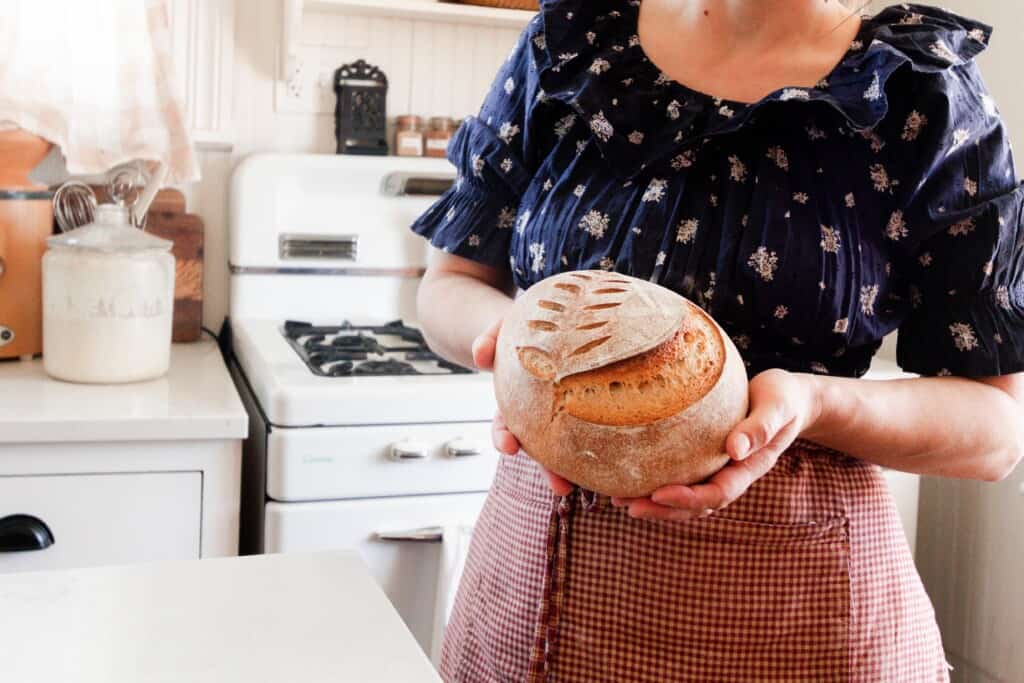
Table of Contents
- Sourdough Bread Baking
- Tips For Making Whole Wheat Sourdough Bread
- Tools you may need:
- 100% Whole Wheat Sourdough Bread Ingredients
- Find More Whole Wheat Sourdough Recipes
- How To Make A Whole Wheat Sourdough Boule
- Bulk Fermentation
- Storage:
- Bakers Timeline For No-Knead Sourdough Bread
- Baker’s Timeline:
- FAQ
- Find More Sourdough Recipes:
- Whole Wheat Sourdough Bread Recipe
*Update: This post has been updated from the original recipe. You can find my whole wheat sourdough sandwich bread recipe here for a delicious sandwich loaf.
I have been on the hunt for a good whole wheat sourdough bread recipe for a long time. When I first made my sourdough starter over seven years ago, I tried my hand at a few recipes I found online and they always seemed to flop.
Maybe I just didn’t have enough experience with bread baking, or maybe I expected it to be as fluffy as white, store-bought bread.
Either way, I gave up on sourdough bread for several years.
I still made my beloved English muffins, pancakes, pizza crusts, sourdough skillets, and tortillas.
But sourdough whole wheat bread just seemed like too much of a hassle and overly complicated.
After getting a few years of sourdough experience under my belt, it seemed a good time to try again.
And now, after playing around with it for a while, I feel like I finally have something that makes a consistently delicious loaf of whole grain sourdough bread every single time.
In fact, since I started making my bread from this recipe, I haven’t had any flops.
If you have been trying to make sourdough bread for a while, you may be all too familiar with the “flops” I’m talking about.
Traditional sourdough bread baking can be a lot trickier than modern-day baking with yeast packets.
After playing around with it for awhile, I feel like I finally have something that makes a consistently delicious loaf of whole grain sourdough bread every single time.
In fact, since I started making my bread from this recipe, I haven’t had any flops.
If you have been trying to make sourdough bread for a while, you may be all too familiar with the “flops” I’m talking about.
Traditional sourdough bread baking can be a lot trickier than modern day baking with yeast packets.
Sourdough Bread Baking
Instead of using a trusty little packet of active yeast that you can just grab at the local grocery store, wild-fermented sourdough bread baking relies solely on the native, wild yeasts to make your bread rise.
This is why results can be inconsistent. You have to have a mature starter that is full of beneficial bacteria and yeasts. If the balance is off, the bread may not rise, resulting in a loaf that more closely resembles a brick than bread.
This recipe for whole wheat sourdough bread produces the least brick-like loaf I have ever had.
Actually, it is ridiculously delicious.
We had a loaf, fresh out of the oven, with dinner tonight, and my husband and I were talking about the wonders of fermented foods.
They just have a depth of flavor that you can’t find in something made quickly. The taste that develops over days, and sometimes weeks, has so much dimension.
I don’t even know how to describe it. My words elude me. You just have to trust me and try it!
This post contains affiliate links, which means I make a small commission at no extra cost to you. See my full disclosure here.
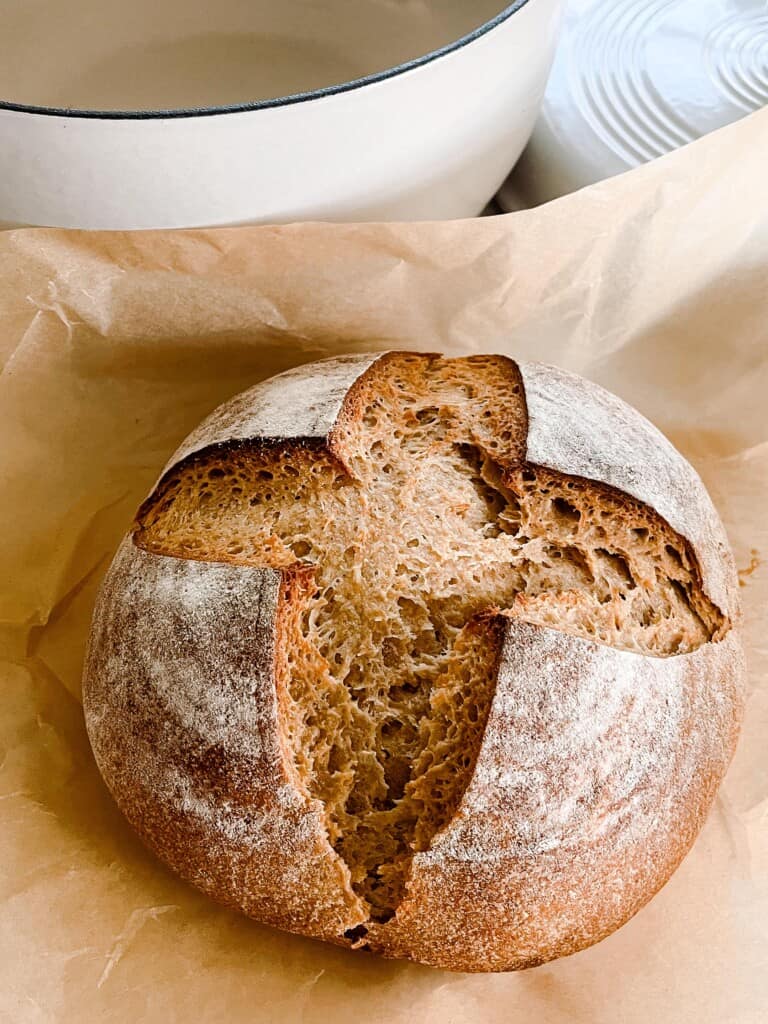
Tips For Making Whole Wheat Sourdough Bread
- Use a sharp serrated knife to cut the bread, or use an electric knife.
- I like to use freshly milled whole wheat using my Mockmill, but you could also use a different kind of whole-wheat flour.
- Don’t expect this to produce super fluffy bread like you would get at the store. This is due to the whole grains. If you want a fluffier loaf, try my no-knead sourdough bread.
- Make sure you feed your sourdough starter eight hours before making this bread.
Tools you may need:
- Stainless steel bread pans
- Mockmill
- Berkey water filter
- Stand mixer (optional)
- Banneton baskets (optional)
- Dough whisk
- Thrive Market You can get 25% off your first order through my link. I love to buy einkorn, gelatin, and coconut milk from here. They have quite a few things that are actually cheaper than Amazon!
- I get my wheat berries from this co-op- Country Life Natural Foods
100% Whole Wheat Sourdough Bread Ingredients
Whole wheat flour – I like to use freshly milled, white wheat berries.
Active sourdough starter – Fed about 4-12 hours beforehand. It should be active and bubbly.
Salt – I prefer sea salt.
Water – Preferably filtered water. We use a Berkey water filter.
Find More Whole Wheat Sourdough Recipes
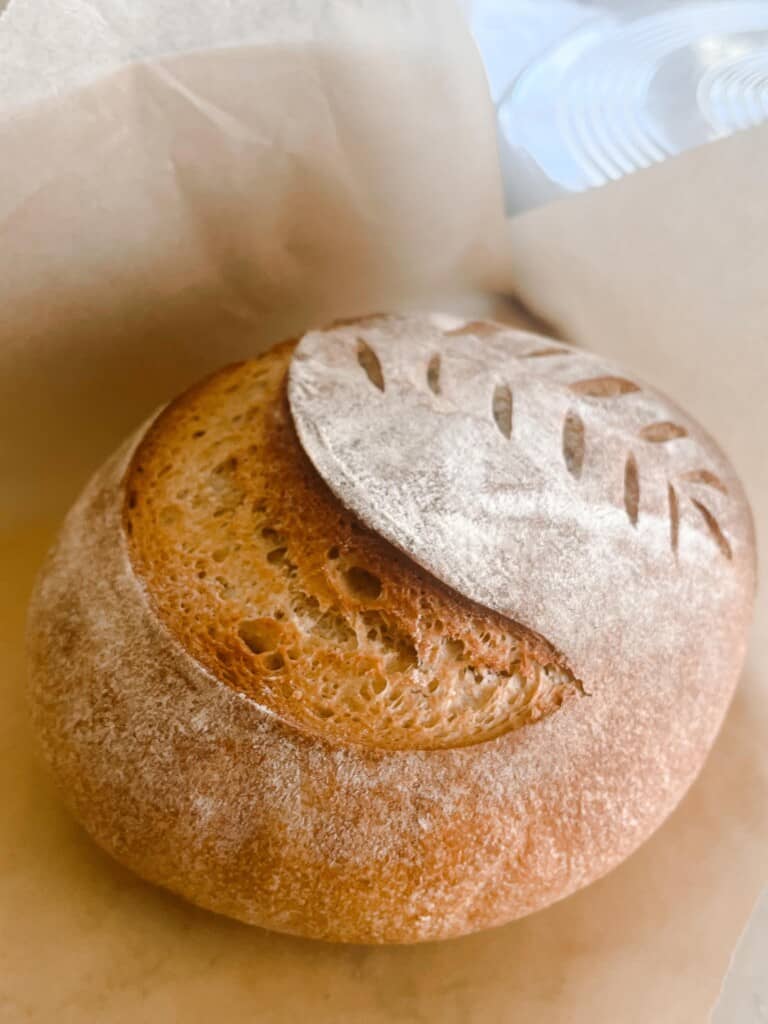
How To Make A Whole Wheat Sourdough Boule
Feed a sourdough starter 4-12 hours before starting the bread, ensuring it is active and bubbly and just about at its peak.
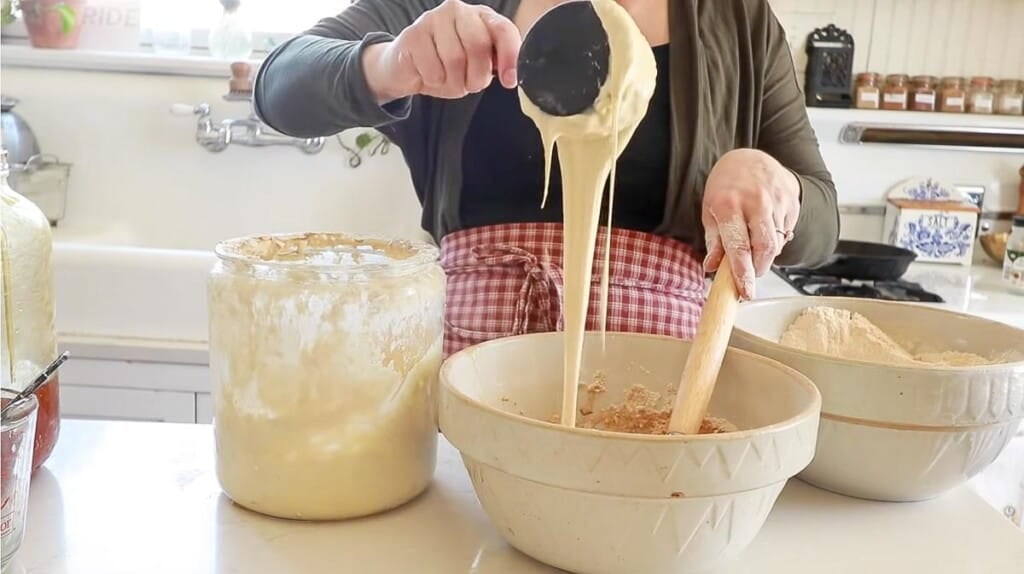
To a large bowl, combine water, active starter, salt, and flour with your hands for about 5 minutes. Cover with a damp towel and allow to rest for one hour for the water to hydrate the flour. This is a process called autolyse, where the flour becomes fully hydrated.

Add more flour if the dough is too wet and sticky. Since the ingredients in this recipe are weighed, it should be pretty consistent.
This is where you will have to play around with the dough and get a feel for it. The hydration of your starter, the weather outside, and the type of flour you use… all will come into play to determine how much flour you will need.
You are looking for a dough that is not too sticky, but also not too dense when you are doing the stretch and folds later.
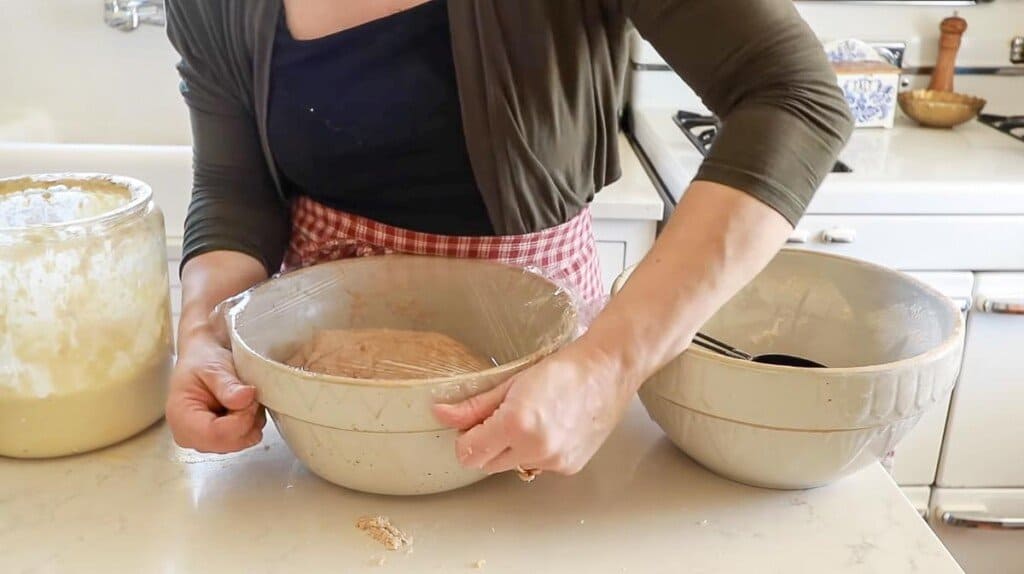
Stretch And Fold
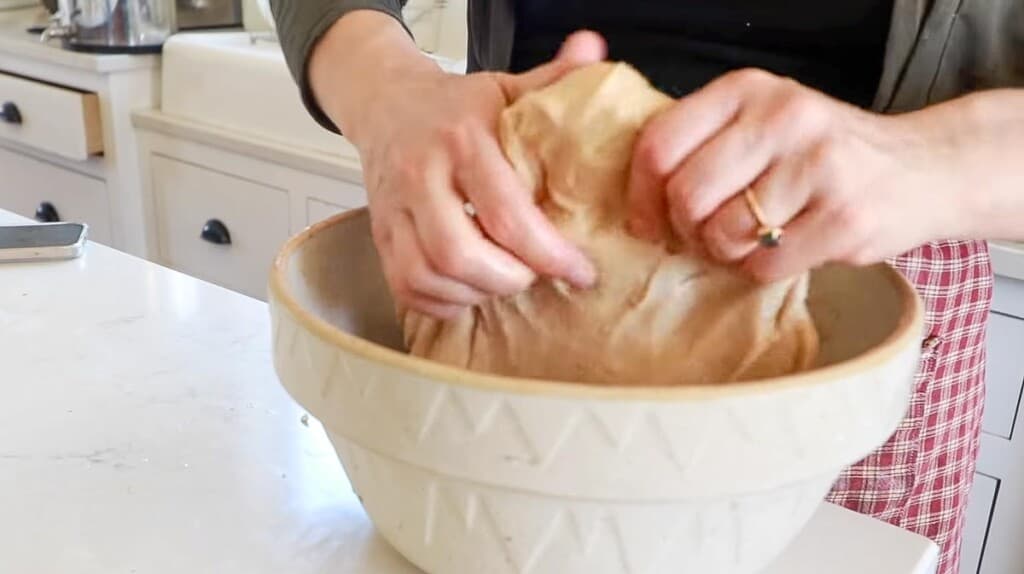
Instead of kneading, I like to do the stretch and fold method. This is where you take the dough on one side and pull it up about 6 inches, then fold it over the rest of the dough. Turn the bowl about 1/4 around and repeat the process. Do this a total of 3-4 times. This is considered one round. Cover.
First 3 stretch and folds – every 15 minutes.
Last 3 stretch and folds – every 30 minutes.
Bulk Fermentation
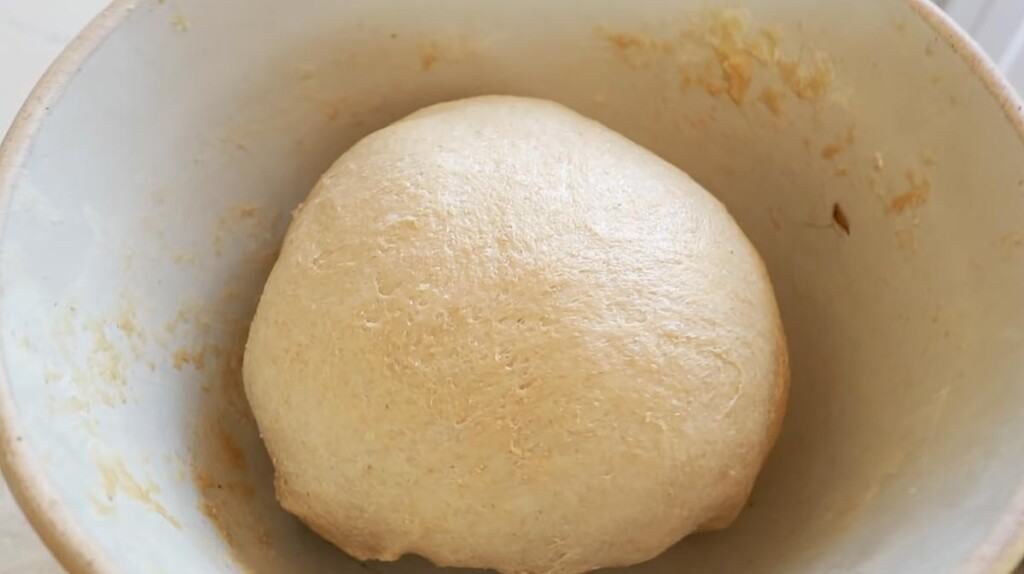
Cover with plastic wrap and allow the dough to bulk ferment in a warm place until doubled. This usually takes my dough about 8 hours.
How long it takes for your dough to double depends on how warm or cool your environment is and how active of a starter you have. The warmer the room, the shorter the fermentation time typically.
Shape And Refrigerate Overnight
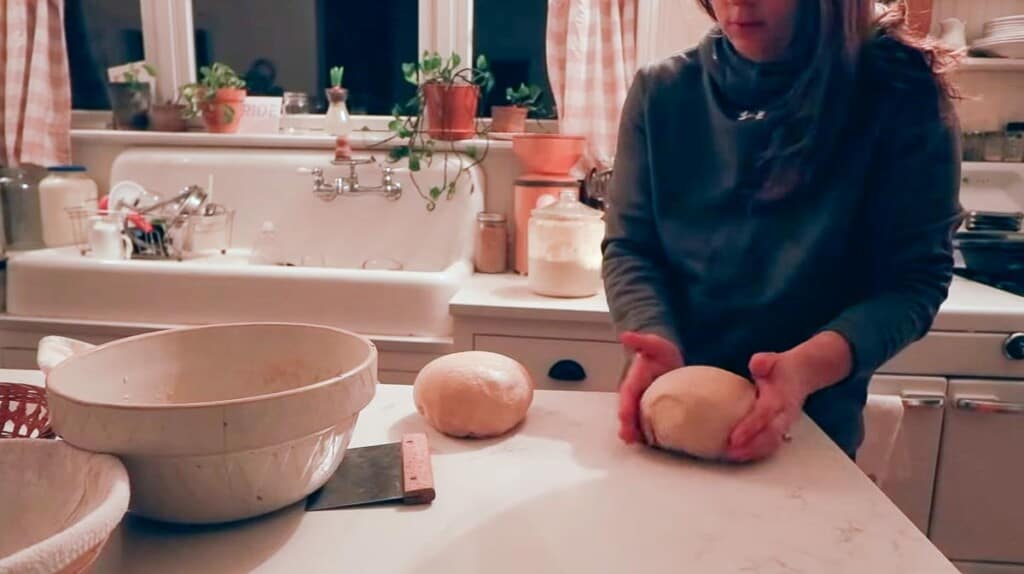
Shape it into a ball by gently spinning it toward you against the countertop, giving it tension. This will help the bread get really puffy.
Let the dough rest for 15-20 minutes uncovered. This helps it develop a little bit of a skin, which helps prevent it from sticking to the lined basket.
Turn over on a floured surface and shape.
Transfer to a lightly floured banneton basket or bowl lined with a tea towel.
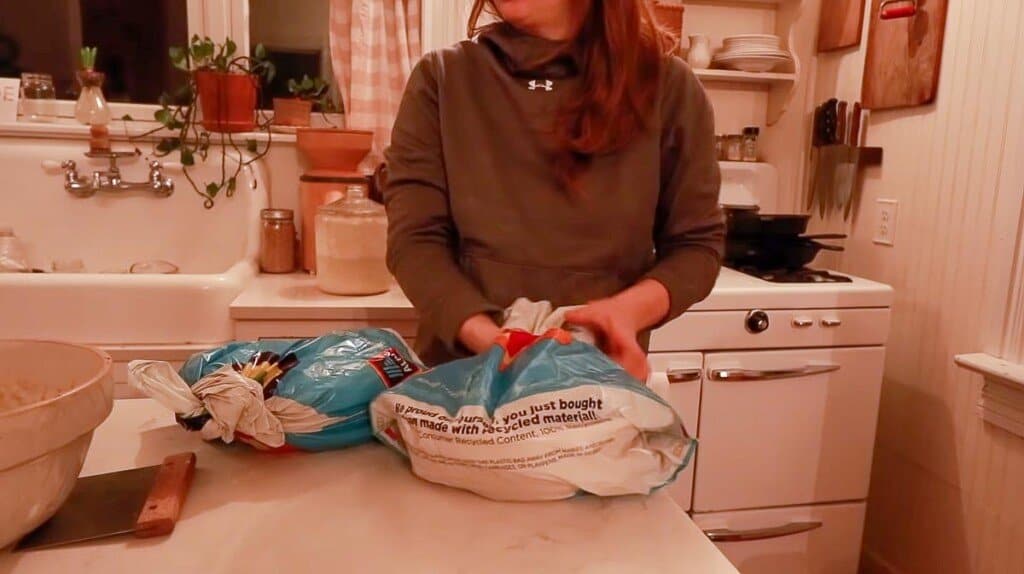
Cover with plastic and proof for 12-14 hours in the refrigerator. I will put the basket in a grocery bag and tie it. You could also let it rise in a warm spot for 2-4 hours.
I like to do the refrigerator option because I can store the dough in the refrigerator for up to a week before baking, and also it is easier to create pretty designs on the top of the dough.
During the refrigerator “rise”, the bread dough will not look like it has risen at all. This is normal. It magically puffs up perfectly during baking.
Bake
Place a Dutch oven into the oven and preheat to 500 degrees.
Whenever the oven is done preheating, remove the dough from the fridge, place on parchment paper, and score with a lame or razor. Find my favorite scoring patterns here.
Dust with flour on top to make the scoring pattern stand out more (optional).
Gently place the parchment paper and dough into the Dutch oven.
Bake for 20 minutes with the lid on and another 20 minutes with the lid off.
Allow to cool completely before slicing. Find my post all about how to cut sourdough bread here.
Storage:
Now while my family inhales a loaf in no time flat, I know that is not true for other families. I will usually just store my bread in the Dutch oven it was baked in. You can also place it in a linen bread bag, or plastic bag. Learn the 7 ways to store sourdough bread to keep it fresh here.
Bread also freezes really well. Just place in a freezer-safe bag, and stow it away. Some people prefer to wrap the loaves in plastic wrap first, then in the bag. It will last 3-6 months in the freezer.
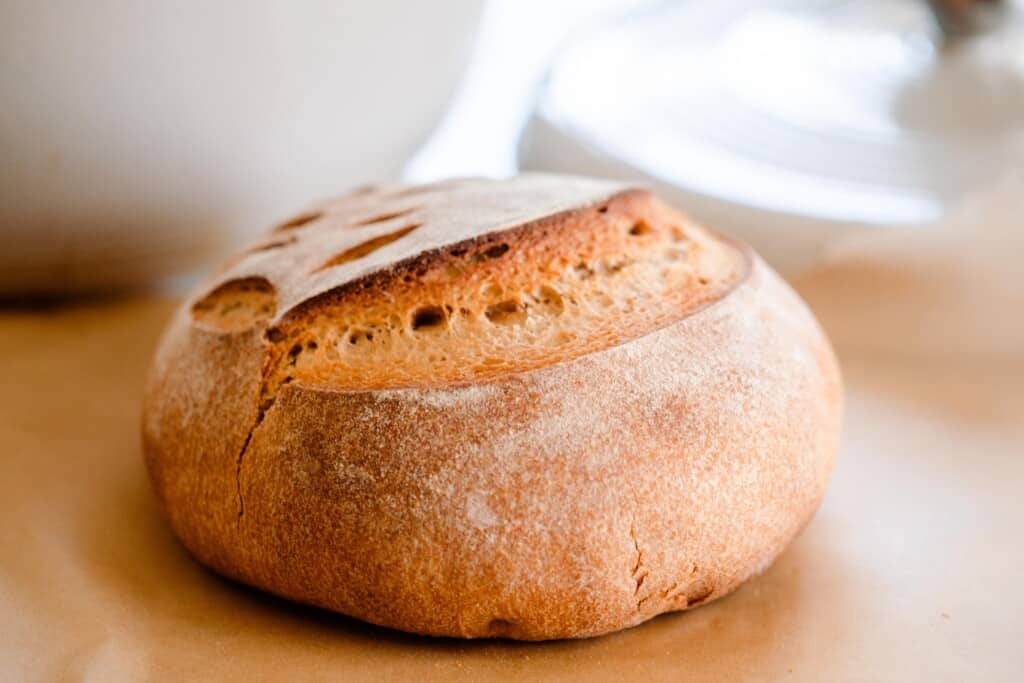
Bakers Timeline For No-Knead Sourdough Bread
Baker’s Timeline:
This can be started or made at any time. I like to start doughs at night time so they can rise all night.
Feed sourdough starter with flour and water.
If sourdough starter is mature, then proceed to creating the dough.
Combine all the ingredients and rest for 1 hour.
Stretch and fold.
First 3 stretch and folds – every 15 minutes.
Last 3 stretch and folds – every 30 minutes.
Cover with a wet towel or plastic wrap and allow the dough to bulk ferment until doubled.
Shape dough.
Set out at room temperature for 15-20 minutes, uncovered.
Turn over and shape.
Transfer to floured banneton or bowl lined with a tea towel and cover with plastic or place in a plastic bag. Place in the refrigerator for 12-15 hours for the second rise.
Preheat Dutch oven at 500 for 1 hour.
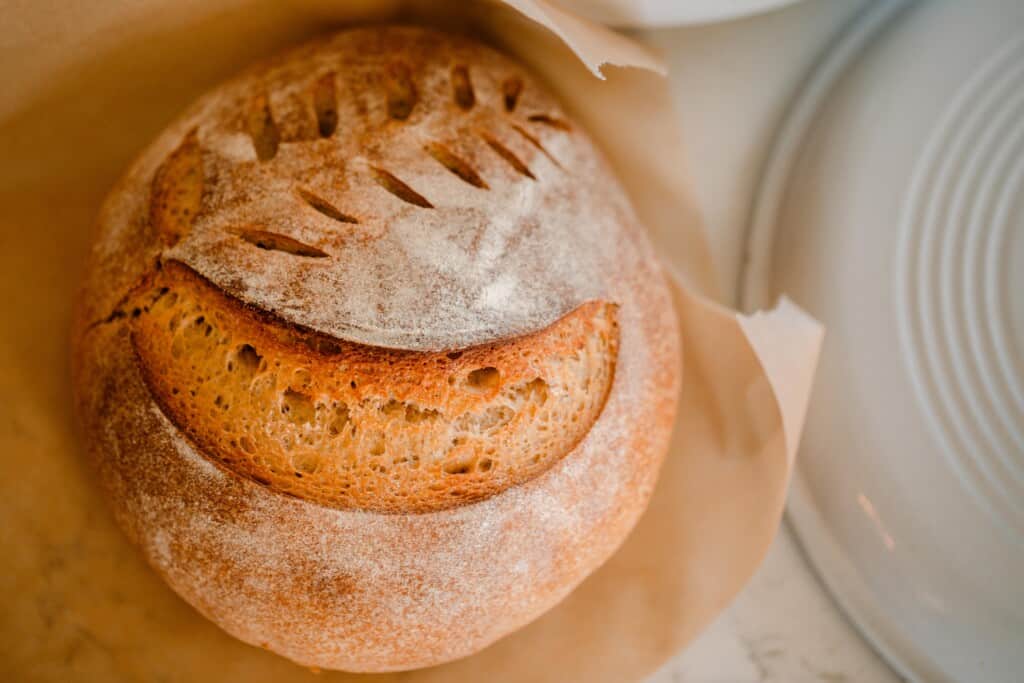
FAQ
Wrap the bread with beeswax wraps, or in a plastic ziplock bag, and store up to two weeks at room temperature.
Fermented whole grain bread keeps longer than unfermented whole grain bread at room temperature. This is because the fermentation process makes the bread less susceptible to mold and fungus.
The same scientific principles that make sauerkraut and lacto fermented salsa keep for several months are at work in the sourdough bread.
For longer storage, you can also keep it in the fridge or freezer. However, the fridge is typically not recommended as it can dry out the bread.
Yes, it will give you a heartier, more dense loaf, with a whole grain flavor. It isn’t going to be as light and fluffy as other sourdough breads made with bread flour or all-purpose, but it is very delicious.
It takes longer than the usual yeast packet, as you are waiting for the natural yeast and bacteria in the air to create the rise. As far as compared to other sourdoughs, whole wheat doughs tend to rise faster than white bread dough.
It will also depend on the hydration of the whole wheat sourdough recipe you use. The higher the hydration, the faster the rise.
Yes. For this recipe, and most recipes, you can easily use a whole wheat starter.
I tend to feed my sourdough starter a variety of flours and don’t stick to a particular one. Sometimes I use einkorn, sometimes all-purpose, and sometimes freshly milled whole wheat.
Not all sourdough is going to be whole grain. This will be determined by the type of flour used in a recipe. Some people like to make their bread with 100% whole grains, while others like to mix the flours for a lighter crumb.
Yes. Whole grains are filled with vitamins, nutrients, and fiber. The fermentation makes the nutrients even more bioavailable so your body will absorb them better.
Absolutely. While the texture is more chewy and less fluffy, it can be done. If you want a fluffier loaf, I would recommend using a combination of white flour and whole wheat flour like my no-knead sourdough bread.
Find More Sourdough Recipes:
- No-Knead Sourdough Bread
- Einkorn Sourdough Bread
- Easy Sourdough Flatbread
- How to Make Sourdough Tortillas
- Low Hydration Sourdough Bread
- Sourdough Pizza Crust
- High Hydration Sourdough Bread
- Small Batch Sourdough Bread
If you make this recipe and love it, I would love if you gave it 5 stars! Tag me on Instagram @farmhouseonboone with your delicious creation.
Whole Wheat Sourdough Bread
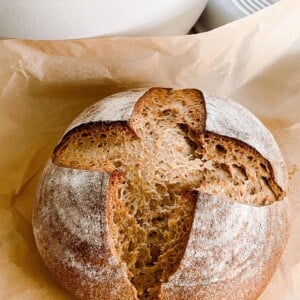
Ingredients
- 475 grams freshly milled whole wheat
- 325 grams water
- 100 grams active starter
- 10 grams salt
Instructions
- Feed a sourdough starter 4-12 hours before starting the bread, ensuring it is active and bubbly and just about at its peak.
- To a large bowl, combine water, active starter, salt, and flour with your hands for about 5 minutes.
- Cover with a damp towel and allow to rest for one hour for the water to hydrate the flour. This is a process called autolyse, where the flour becomes fully hydrated.
Stretch And Fold
- Instead of kneading, I like to do the stretch and fold method. This is where you take the dough on one side and pull it up about 6 inches, then fold it over the rest of the dough. Turn the bowl about 1/4 around and repeat the process. Do this a total of 3-4 times. This is considered one round. Cover.
- First 3 stretch and folds – every 15 minutes.
- Last 3 stretch and folds – every 30 minutes.
Bulk Fermentation
- Cover with plastic wrap and allow the dough to bulk ferment in a warm place until doubled. This usually takes my dough about 8 hours.
Shape And Refrigerate Overnight
- Shape it into a ball by gently spinning it toward you against the countertop, giving it tension. This will help the bread get really puffy.
- Let the dough rest for 15-20 minutes uncovered. This helps it develop a little bit of a skin, which helps prevent it from sticking to the lined basket.
- Turn over on a floured surface and shape.
- Transfer to a lightly floured banneton basket or bowl lined with a tea towel.
- Cover with plastic and proof for 12-14 hours in the refrigerator. I will put the basket in a grocery bag and tie it. You could also let it rise in a warm spot for 2-4 hours. I like to do the refrigerator option because I can store the dough in the refrigerator for up to a week before baking, and also it is easier to create pretty designs on the top of the dough.
Bake
- Place a Dutch oven into the oven and preheat to 500 degrees.
- Whenever the oven is done preheating, remove the dough from the fridge, place on parchment paper, and score with a lame or razor. Find my favorite scoring patterns here.
- Dust with flour on top to make the scoring pattern stand out more (optional).
- Gently place the parchment paper and dough into the Dutch oven.
- Bake for 20 minutes with the lid on and another 20 minutes with the lid off.
- Allow to cool completely before slicing.
Notes
- I like to use freshly milled whole wheat using my Mockmill, but you could also use a different kind of whole-wheat flour.
- Don’t expect this to produce super fluffy bread like you would get at the store. This is due to the whole grains. If you want a fluffier loaf, try my no-knead sourdough bread.
Nutrition
Nutrition information is automatically calculated, so should only be used as an approximation.

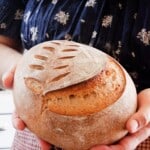
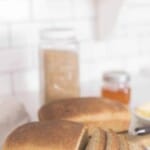














Do you have a recipe for the loafpan version of this? When I try to ‘print’ all that comes up is a boule version. Thanks!
I can only add one recipe card, unfortunately! So your best option would probably be to copy from the blog post and paste into a doc to print. Sorry about that! I also have this whole wheat sandwich loaf recipe here: https://www.farmhouseonboone.com/whole-wheat-sourdough-sandwich-bread
I have yet to attempt this recipe do you have to do the shape and cold ferment or are you able after 8-12 hours of letting it rise after the series of folds could be baked? Provider it did rise.
You can try baking it after 8-12 hours, but I always fine it does best after the shape and cold ferment.
I am new to all this bread making and I’m so glad to find that it is so simplified. Many times it seems like other explanations of making a starter is so complicated. Thank you for sharing all your wisdom and making us believe that we can do it too!
So glad!! Hope you enjoy all the baking in your future!
Once mixed for the Boule this came in a tough clump so I went with it. I could barely stretch and fold. It was so thick and kind of stretchy but I had to really pull it. This morning it may have risen a bit. Do I stay with it and refrigerate for the 12 hours or dump it?
Oh no! It may need longer to rise. Sometimes it will take more than 12 hours depending on the temperature of your home. I would still bake it. If it doesn’t work out you can always turn it into French toast casserole, strata, bread crumbs, bread pudding or something else. If you find your dough is really tough, you may need to add more water. An easy way to do this is by getting your hands wet during the stretch and folds.
Same the Ng happened to me. I realized after the first 20 min rest before the stretch and folds.. I did not have enough water! I decided to try adding quite a bit if water and mixed with my hands to make quite a wet dough. Then I started the process over- I set a timer for 20 min, and it was ready for stretch and folds!! I was showed. I proceeded with the 3 15 min and the 3 30 min, and it was PERFECT. My last few tries of bread resulted in the very stiff thick dough, and I never put it together that it was too dry.hope this helps!!
How much water did you add? I made this and I could hardly do any stretches. I thought there wasn’t enough water but I wanted to trust the recipe. I’ll try again tomorrow with more water.
Same thing for me too! Just added water. Fingers crossed it works!
How do you measure out your wheat berries when grinding flour? I’ve tried 2/3 cup whole berries to equal one cup of flour and I’ve also done 120 g of berries to equal a cup. Would love to know what you go by!
Thanks!
Honestly, I normally don’t weigh my wheat berries and just guess most of the time. But you can weigh out the amount of wheat berries (most of my recipes use 140/150 g per cup of flour) before grinding.
Is the honey needed to make this bread rise? Or affect softness or is it just for taste?
It helps feed the yeasts and adds a slight sweetness to the bread.
Could you use butter in place of the coconut oil?
And what freshly milled grain do you prefer to use with this recipe?
Thanks for all your efforts and tips!
I would think that would work just fine. I use white wheat berries.
I wrote a few weeks back- maybe it didn’t get through, or edited out? Not sure- but I really really think that your recipe has less than half the water it needs. You only add 350 grams- and yet have pushing 1000 grams of flour- that can’t be right, 30% hydration? despite using some oil and honey. I added another 300 g of water and it made it workable, great in fact, but otherwise you get a brick. Edible, but I’d never give it to anyone. I think you have a typo in this recipe- please check and save future readers some frustration. I think your website is awesome BTW, so totally trying to be helpful here.
Sorry Matthew, I did originally see your comment and made a note to retry the recipe. This is a very old recipe that I’ve made many times, but you never know. There are many variables when it comes to sourdough baking, but that is a lot of water that needed to be added. So I will retry. Thanks for sharing that.
Thanks for looking into this- its really a great recipe. I’ve baked this 10 plus times 4 loaves at time for a month now (I give my loaves to neighbor’s and friends),and getting great responses- and I’ve bakes 100s of APF loaves following your recipe (maybe a 1000? seriously)- but this one is a step above that. I use your standard sourdough proportions- starter plus 950 g of flour (currently I use 100 g rye, 100 g bread flour, and the rest whole wheat, but all whole wheat would prob be best (haven’t tried), and 650 g of warm water. Plus the oil, salt, and sugar. I bake it covered at 450 for 25 minutes, then drop to 425 til it gets to 208 at the center. The sugar makes it have this amazing dark color- not burnt,but dark. So different than what I expected, and lots of room for experimenting. Getting very active starter seems to make a big difference in getting rise,moreso than standard sourdough, and so does figuring out how to get the temperature right and the covered time right. I’m still dialing it in, but getting super positive feedback- especially if one wants whole grains and doesn’t want to make a brick. Kudos to you for making this happen. It doesn’t replace the excellent standard sourdough, but is a nice balance! Thanks again.
I wish I’d read onto the second page of comments to see Matthew’s notes before trying this recipe, and having to do emergency triage mid-knead!
My usual sourdough recipes come from Emilie Raffa’s book (and website, Clever Carrot), but she doesn’t go fully whole wheat. This approach looked interesting, especially with all the comments and positive reviews, but once I got all the flour in there, there was NO way it was going to work: completely locked and solid. I added 300 grams of water at that point, which made a huge mess, then worked in another 120 grams of flour. That was too much, really, because it made the subsequent folding more challenging, but it was the only way to persuade the water to absorb.
Matthew, have you thought of posting your version onto your website (even though that’s mostly about bees and honey)? Your approach was exactly what I needed, and the Farmhouse one just WASN’T.
I’m sorry you didn’t have very good luck with this recipe.
Now I’m wondering about the amount of for, not the water! Now that I’ve watched the video on YouTube, that is.
Your recipe calls for 1050 grams of flour, but in the video you use 6 cups. In theory, you should get about 4 cups of fresh ground flour from a pound of wheat berries, so that’d be more like 650 grams of flour.
When I weighed 6 cups of my WW flour just now, it came in at 690 grams.
Like Matthew suggested, I really think you might want to follow your written instructions to confirm them.
Thank you for this recipe! My first 100% whole wheat sourdough. It came out great! Crusty outside, nice and soft inside. Not milling my own wheat yet. Maybe one day…
Yay! Great to hear.
Could you cut this recipe in half and just make one loaf?
Yes for sure!